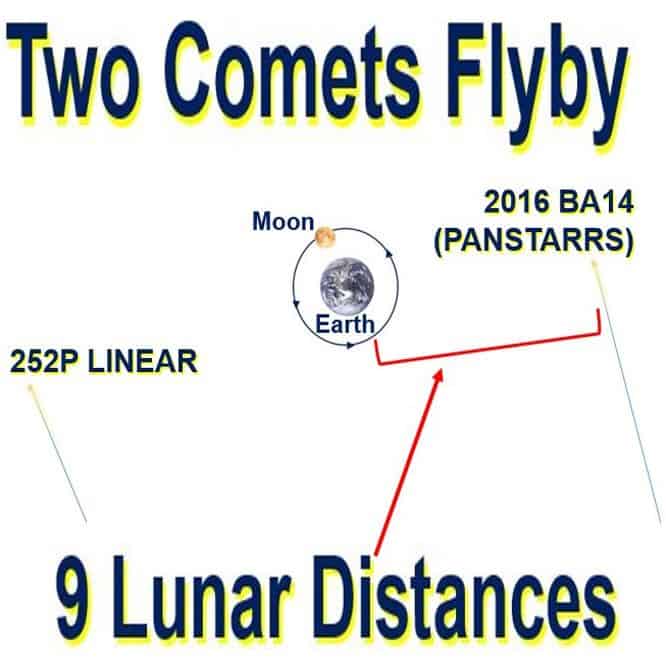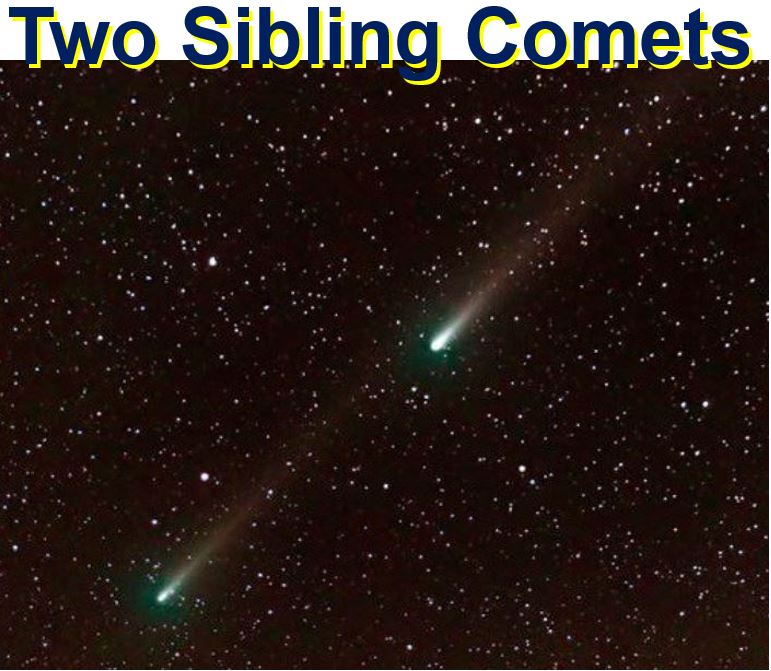Two comets will be flying super close to Earth next week – astronomically speaking, they will miss our planet by just a whisker. However, don’t panic – the closest one will flyby at about nine lunar distances; the distance from here to the Moon multiplied by nine, i.e. 2.1 million miles (3.4 million kilometres).
The last time a comet did such a close flyby was 246 years ago. The closest flyby we know of occurred in 1770, when Lexell’s Comet missed our planet by just 1.4 million miles (2.2 million km).
The two comets will by ultra-near to us on the 21st and 22nd March. The one scheduled for 22nd March at about 16:00 UT – Comet PanSTARRS (P/2016 BA14) – will be the second closest ever recorded.
 Two two flybys will be very close, one of them – 2016 BA14 – the second closest in recorded history. However, at a distance of 2.1 million miles (9 lunar distances), there is no chance of a collision with Earth. (Image: adapted from nasa.gov. Not to scale)
Two two flybys will be very close, one of them – 2016 BA14 – the second closest in recorded history. However, at a distance of 2.1 million miles (9 lunar distances), there is no chance of a collision with Earth. (Image: adapted from nasa.gov. Not to scale)
Get out your telescopes!
P/2016 BA14 will speed from Canis Major to Ursa Major over a period of seven nights. If you have a telescope you should be able to see it. This comet was discovered on 21st January, 2016 by the PanSTARRS 1 telescope, located at the summit of Haleakalā on Maui, Hawaii – it was given an asteroid designation 2016 BA14.
NASA says scientists initially thought P/2016 BA14 was an asteroid: “But follow-up observations by a University of Maryland and Lowell Observatory team with the Discovery Channel Telescope showed a faint tail, revealing that the discovery was, in fact, a comet.”
Denis Denisenko, a Russian astronomer, soon noticed that the comet’s orbit was very similar to that of 252P/LINEAR, which was discovered sixteen years ago. It is on course for a close approach to Earth this month.
Writing in Sky & Telescope, Bob King wondered whether the two comets might be related.
Matthew Knight and Michael Kelley, both astronomers, were also curious about the two comets and whether they might be siblings, so they observed 2016 BA14 with Lowell Observatory’s Discovery Channel Telescope last month. Their images revealed a tail.
 An artists impression of the two sibling comets – 2016 BA14 and 252P/LINEAR. (Image: sociedadastronomia.com)
An artists impression of the two sibling comets – 2016 BA14 and 252P/LINEAR. (Image: sociedadastronomia.com)
Two comets likely have common origin
The two comets have almost identical orbits with virtually the same period of 5.32 and 5.25 years (252P and BA14 respectively) – this suggests they have a common origin. Most likely a large chunk of 252P/LINEAR became separated to become P/2016 BA14. The ‘P’ designation means that the comets make repeat orbits around our Sun.
Paul Chodas, manager of NASA’s Center of NEO Studies at the Jet Propulsion Laboratory in Pasadena, California, said:
“Comet P/2016 BA14 is possibly a fragment of 252P/LINEAR. The two could be related because their orbits are so remarkably similar. We know comets are relatively fragile things, as in 1993 when comet Shoemaker-Levy 9 was discovered and its pieces linked to a flyby of Jupiter.”
“Perhaps during a previous pass through the inner-solar system, or during a distant flyby of Jupiter, a chunk that we now know of as BA14 might have broken off of 252P.”
At the moment, 252P/LINEAR, which has the comet community in a buzz, is only visible in the Southern Hemisphere. However, in a couple of days it will move into Scorpius’ tail at 6th magnitude. It’s sister comet, P/2016 BA14, is also headed north at breakneck speed.
 Comet Kohoutek. As comets get closer to the Sun, their characteristic tails get longer. (Image: northwestern.edu. Credit: From NASA’s Image Exchange http://nix.nasa.gov/nix.cgi)
Comet Kohoutek. As comets get closer to the Sun, their characteristic tails get longer. (Image: northwestern.edu. Credit: From NASA’s Image Exchange http://nix.nasa.gov/nix.cgi)
During its closest approach on 22/23 March, P/2016 BA14, which is tiny and with a faint 15th magnitude, will brighten rapidly and reach magnitude +12. Most astronomers expect it to show a large *coma, especially in long-time exposure photographs.
*A comet’s coma is the nebulous envelope around its nucleus. It is formed when the comet gets closer to the Sun on its highly elliptical orbit; as the comet warms, parts of it sublimate.
Bob King wrote:
“Although the full Moon will make a mess of things at that time, we get a break by the 24th when the Moon rises at twilight’s end, allowing for a brief window of darkness. At that time, the comet will be beautifully placed, flying across Ursa Major at the rate of 13° per day or more than 1/2° per hour.”
“Between March 21st and 22nd, it covers an incredible 20° in 24 hours, fast enough to detect motion in less than a minute through a telescope. Provided it brightens as hoped, that is.”
NASA says the approaches of these two comets will be the closest they come to our planet for the foreseeable future.
“March 22 will be the closest comet P/2016 BA14 gets to us for at least the next 150 years. Comet P/2016 BA14 is not a threat. Instead, it is an excellent opportunity for scientific advancement on the study of comets,” Chodas said.
What are comets?
According to Northwestern University, comets, sometimes referred to as ‘dirty snowballs’, are left over from the formation of stars and planets many billions of years ago.
Before orbiting around the Sun at high speed with their characteristic long tails, the comets that we see in our Solar System started out as large chunks of ice and rock floating round in the Oort Cloud, an extended shell of icy objects that exist in the outermost reaches of the solar system.
When the gravity of a large passing body, such as a star, becomes powerful enough, some big chunks of ice get pulled away from the cloud and race towards the Sun.
As the ball of ice approaches the Sun, its heat starts to melt some of the ice that makes up the comet. The melted ice turns into a gaseous tail that extends away from the Sun – this tail is pushed out by our Sun’s solar wind.
Comets keep moving and get their trajectories from the gravity of all the planets and stars they fly close to. When a comet is in our Solar System, most of its motion comes from the Sun’s gravity.
As it gets closer to the Sun, the comet moves at higher and higher speed, because the nearer it is to the Sun the stronger its gravity acts on it. The comet’s tail also gets longer because more of the ice is evaporating.
Video – Close up of two comets
This animation shows the orbits of comets P/2016 BA14 and 252P/LINEAR as they flyby Earth in March 2016.

